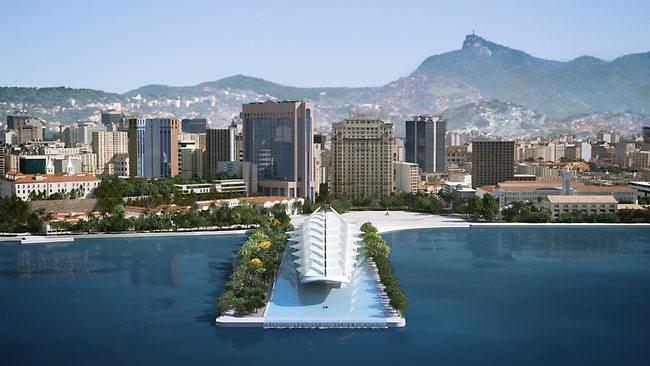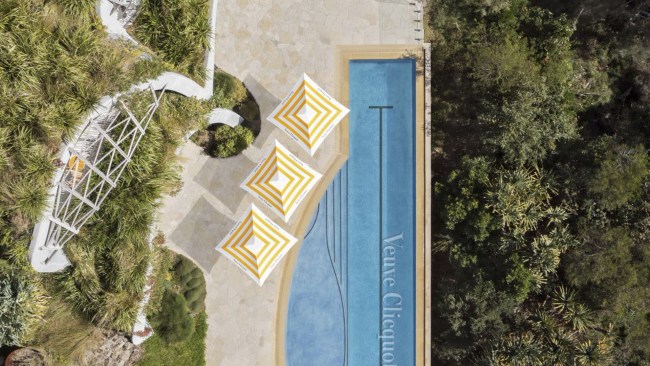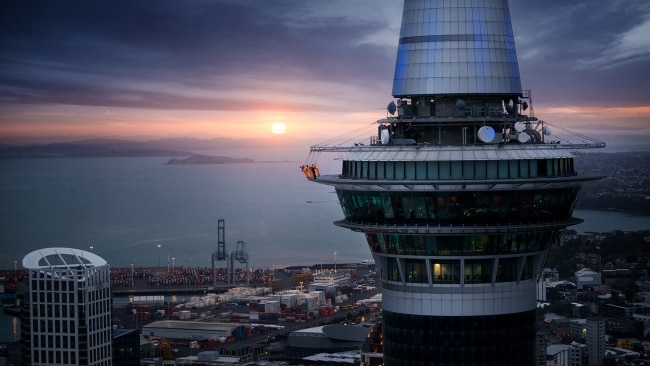Rio on the rise
NOT everyone is happy about the rejuvenation of Brazil's tourist gateway.

EVEN from a distance, I can make out Rio Art Museum's distinctive roof rising above a clutter of scaffolding, cranes and boarded-up building sites. Tracing delicate arcs through the sky above Rio de Janeiro's run-down port, the wave-form roof unites the museum's main building, a classical-style palace erected in 1918, with a newly built, glass-walled annexe.
Unveiled in March, the new museum illustrates Rio de Janeiro's history through art and design. I know its eclectic collection of works will be compelling. But once inside, I follow most other visitors and head straight to the rooftop bar.
For months, Rio has been gearing up to host key elements of the FIFA World Cup, which kicks off at the city's Maracana Stadium in June next year. In 2016, Rio again hosts an international sporting event when it will become the first city in South America to hold the Olympic Games. As authorities have rushed to spruce up everything from soccer stadia to the city's infamous favela slums, the museum's roof terrace offers a unique view of the kind of reborn city that is likely to emerge.
"Rio's port dates from the city's founding years. It has incredible buildings and some great stories, but it's been abandoned and derelict for so long that [Rio residents] Cariocas have almost forgotten it's there," says Rob Burhoe, the Canadian-born owner of O Veleiro, a B&B in a private home in Botafogo. He regularly guides his guests around the city's cultural sites.
From the terrace, we can see the Maua Pier jutting out into the glittering waters of Guanabara Bay, where workers are putting the finishing touches to a white-ribbed, arrow-like structure. Designed by Santiago Calatrava, the skeletal building will open next year as the Museum of Tomorrow, dedicated to science and technology.
To our left, a long line of warehouses and wharves that once served White Star Line passenger ships have already been fastidiously restored, their brick facades scrubbed and painted, their roofs re-lined with corrugated iron. Far beyond, I can just make out engineers taking measurements for a new road bridge crossing the bay.
Known as Porto Maravilha, or Marvellous Port, the scheme to transform the port into a vibrant tourist and business hub includes new docking facilities for cruise liners, a light railway and an incubator for artists on Morro da Conceicao, one of the five hills originally settled by Portuguese colonists.
A highlight for foreign visitors is the planned demolition of Elevado da Perimetral, an elevated highway that cuts brutally through the city's historic district. The busy road, which connects Rio's northern districts with its downtown, is being replaced in sections by a 6km tunnel. Finance to meet the project's 8 billion Brazilian real ($3.7bn) costs has come via the sale of new building permits to developers and investors.
City planners, who say they aim to make the district desirable for residents and tourists alike, have striven to avoid the sense of soullessness that has overshadowed similar docklands schemes in other countries. Parks, plazas and other green spaces feature prominently. Power cables, too, are going underground, a concession to urban aesthetics all too rare in South America.
Protection for heritage buildings has also been paramount, particularly after archeologists uncovered the ruins of Valongo Pier, a notorious wharf where millions of African slaves were landed and sold to plantation owners on the quayside. Chillingly, investigators also located a slave cemetery where those too ill to continue were hastily buried.
The Rio Art Museum has emerged as the project's cultural anchor. Eclectic works donated by private collectors include 19th-century oils by Paris-born landscape artist Henri Vinet, which offer intriguing glimpses of the beach areas of Copacabana and Ipanema long before high-rise apartment blocks and hotels lined the shores.
In one room, 1940s film posters hang alongside promotional ads for former national airline Varig, their stylised art deco lines portraying the city in its dreamy golden years. In the final salon, contemporary city shots by local photographer Claudia Jaguaribe sit alongside a mock-up of a favela crafted in naive-art style.
The port project, in turn, is part of wider revamping efforts taking place across the city. All across Rio, in fact, I find pockets of renovation and renewal. On the fabled beach at Copacabana, where sailors and rowers will compete for Olympic gold in 2016, workers have replaced cheap-and-cheerful coconut stands with glass-walled cafes that allow unsullied ocean views. Clunky plastic furniture with brightly painted advertising has given way to stylised steel tables and slimline chairs.
Coconuts, locals mutter, are now twice the price. But beach users have welcomed new luxuries such as showers, lockers and lavatories in slick changing rooms installed underground.
In the Maracana district, Brazil's national soccer stadium has emerged from a three-year, $550 million revamp. In its former state, fans revered the stadium despite its cracked concrete and dripping pipes. The new-look stadium, earmarked for key World Cup games and the Olympics opening ceremony, is spotless and structurally sound, although "a little less Brazilian than before", as a passer-by notes.
All over the city, in fact, municipal authorities have sought to make Rio cleaner, safer and more modern. Health inspectors have flexed their political muscle by raiding the city's most exclusive restaurants in search of sanitary hazards and expired food. Last month, city hall launched an anti-litter campaign backed up by draconian fines for citizens caught dropping trash.
Locals broadly approve, although many question the financial outlay involved in transforming Rio for a largely foreign audience. Brazil's expenditure estimates on stadiums and infrastructure improvements for the World Cup have risen sharply since the country was awarded the tournament in 2008. The sports ministry now forecasts an outlay of BRL$30bn, which is almost three times what it cost Germany to host the 2006 World Cup.
To the frustration of most Brazilians, the cost of living here has already soared in recent years on the back of a booming economy and a strong currency. "My landlord doubled my rent overnight," says Dilson, a fashion clothing salesman in Botafogo Praia shopping mall. "I looked for a cheaper place but anything similar was even more expensive, so I ended up swallowing my anger and paying up."
In July, frustration over a rise in bus fares spilled over into several weeks of protests and demonstrations. Even the city mayor, Eduardo Paes, has been sanguine about the limits to what can be achieved. "It's not like we're going to be perfect by the end of the Games," Paes told journalists last year. "Rio still has a long way to go, but it is going to be a more equal, more just and more integrated city after the Games."
Perhaps the most controversial element is the city's efforts to restore law and order to the 750-odd shanty towns. In 2008, authorities launched a "pacification" campaign in which elite police units, military helicopters and light tanks cleared out the drugs gangs, often without firing a shot. Municipal staff followed up to kickstart much-needed social services such as schools, health clinics and rubbish collection.
After five years, just 30 of the city's favelas have been "pacified". But the policy has sparked a vogue for favela visits among curious foreign visitors. Many travel agencies offer favela walking tours, while a scattering of hostels and B&Bs has opened in some newly pacified shanty towns. In Vidigal, a once-desperate slum with stunning views of Ipanema, up-and-coming restaurant Bar Lacubaco has even begun to woo foreign tourists with seafood stews and tapioca omelettes.
On my last day in the city, Burhoe and I drive through heavy unseasonal rain to Bonsucesso station, a commuter hub in the city's northern suburbs, where a new cable-car system rises into the Complexo do Alemao, an extensive hillside shanty town pacified in 2011 at a cost of 30 lives.
A spotless, eight-person carriage whisks us over a wide panorama of cement-block houses, each topped with washing line and plastic water tank, a ragged landscape that spreads as far as we can see. The six-station line stretches for 3.5km of unbroken slum.
At street level, I know the Complexo do Alemao will be a cacophony of noise. In every favela, music erupts on all sides as powerful sound systems pump from stores, street markets and private houses. The roar of trucks competes with the blare of salesmen advertising their wares through megaphones.
Up in the cable car, however, we glide in eerie silence. Just an occasional shout floats up from the tightly packed alleys. At Palmeiras station, the last stop, I fall into conversation with Anderson Galves, a new breed of community cop who counsels youths on drug prevention. "There are many here who would like to see the traffickers return," Galves tells me. "It's not been an easy transition."
The comment, I realise, could easily apply to the whole city. A clean, safe and modern Rio? Now that really would be a transition.
Checklist
Venue cities for the FIFA World Cup next year will not be known until the final draw on December 6. Individual tickets went on sale on August 20. More: sporttours.com.au; eclipsetravel.com.au; fifa.com.
• portomaravilha.com.br
• oveleiro.com


